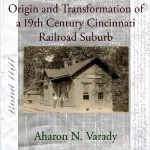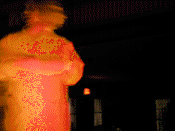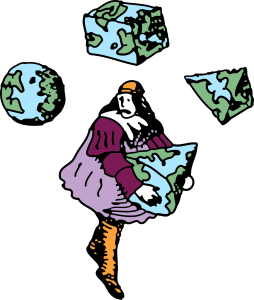Welcome to my home here on the Internet, a space I use to jot down thoughts and comments and ideas to be synthesized later. Less a personal journal of my life and psyche and more of a portal into a sort of personal noösphere – a meta-brain for storage and synthesis, a little space where I can work on articulating an insight and, through that exercise, process all sorts of ideas that I want to invest more time and study. You’re welcome to peruse it and to learn more about me. Please comment or contact me if you feel the urge to do so while reading. I’m also buoyed by words of appreciation.
About me
I think, read, and write about mythology, roleplaying as a spiritual praxis, symbolism, and other ephemera that reveal their relevance in mysterious epiphanies. I enjoy bicycling, canoe camping, cloud watching, hammock sailing, practicing the dérive while exploring new cities and towns, and learning more about urban planning, nature, and myth. I think of my work as advancing a humane tradition within Judaism that envisions progress in universalist terms: the widespread adoption of animal welfare, environmental, and social policies that seek to moderate and curtail human predation — a world in which the voiceless and vulnerable are well protected. I live in Cincinnati with my parents and my cats, Henry, Effie, and Bob.
 Professionally, I’m a community planner (M.C.P.) and a Jewish educator (M.A.J.Ed.). Separately and in tandem, these two orienations translate into my working to improve stewardship of the Public Domain, be it the physical and natural commons of urban park systems or the creative and cultural commons of Torah study. I founded the Open Siddur Project. My advocacy for the free-culture movement and the adoption of Open Source strategies in the Jewish community has been written about in the Yiddish Forverts, Atlantic Magazine, Tablet, and Haaretz. I teach basic ecology and Jewish environmental wisdom, mainly to children, but occasionally to adults as well. I also publish books on Jewish myth, magic, theurgy, fantasy, legend, and lore through Dimus Parrhesia Press. For many years now, I’ve been working to revive the Rosh Hashanah la-Behemot, the New Year’s Day festival for (mainly, Domesticated) Animals.
Professionally, I’m a community planner (M.C.P.) and a Jewish educator (M.A.J.Ed.). Separately and in tandem, these two orienations translate into my working to improve stewardship of the Public Domain, be it the physical and natural commons of urban park systems or the creative and cultural commons of Torah study. I founded the Open Siddur Project. My advocacy for the free-culture movement and the adoption of Open Source strategies in the Jewish community has been written about in the Yiddish Forverts, Atlantic Magazine, Tablet, and Haaretz. I teach basic ecology and Jewish environmental wisdom, mainly to children, but occasionally to adults as well. I also publish books on Jewish myth, magic, theurgy, fantasy, legend, and lore through Dimus Parrhesia Press. For many years now, I’ve been working to revive the Rosh Hashanah la-Behemot, the New Year’s Day festival for (mainly, Domesticated) Animals.
 As an educator I aim to foster my student’s confidence in their creative capabilities, their curiosity in local history and ecology, and ultimately, their taking responsibility for the needs of all beings directly and indirectly impacted by their lifestyle and dietary choices. Over the last decade, I’ve been increasingly engrossed in Judaic Studies, especially early Judaism, ancient and medieval mythology, and attitudes towards non-human animals and predation. I’m really excited about using tabletop roleplaying and storytelling as a problem based learning modality for developing increased fluency in the more esoteric and (for me) interesting realms of the Jewish cultural imagination — and I’ve been working on an roleplaying game system along these lines called Midbar Quest™. I studied experiential education at the William Davidson School of Education.
As an educator I aim to foster my student’s confidence in their creative capabilities, their curiosity in local history and ecology, and ultimately, their taking responsibility for the needs of all beings directly and indirectly impacted by their lifestyle and dietary choices. Over the last decade, I’ve been increasingly engrossed in Judaic Studies, especially early Judaism, ancient and medieval mythology, and attitudes towards non-human animals and predation. I’m really excited about using tabletop roleplaying and storytelling as a problem based learning modality for developing increased fluency in the more esoteric and (for me) interesting realms of the Jewish cultural imagination — and I’ve been working on an roleplaying game system along these lines called Midbar Quest™. I studied experiential education at the William Davidson School of Education.
 As a community and environmental planner, I look for ways in which I can preserve habitat and conserve open space through the planning and redevelopment of human settlements, creating recreational and wildlife corridors in urban greenways, and in general, to apply innovative green solutions to traditional planning problems. I’m happy to help people recognize and appreciate the environmental, historic and architectural assets under their noses. Curious people make for vital neighborhoods and caring societies — and so to this end I wrote a book on the planning history of a neighborhood in Cincinnati. (More about this book below.) In the spring of 2007, I joined the American Institute of Certified Planners.
As a community and environmental planner, I look for ways in which I can preserve habitat and conserve open space through the planning and redevelopment of human settlements, creating recreational and wildlife corridors in urban greenways, and in general, to apply innovative green solutions to traditional planning problems. I’m happy to help people recognize and appreciate the environmental, historic and architectural assets under their noses. Curious people make for vital neighborhoods and caring societies — and so to this end I wrote a book on the planning history of a neighborhood in Cincinnati. (More about this book below.) In the spring of 2007, I joined the American Institute of Certified Planners.
 I studied environmental planning, GIS, and planning history at DAAP/University of Cincinnati (2002-2004), and pedagogy, curriculum design, and experiential education at the Davidson School of Education/JTSA (2011-2013). As an undergraduate, I studied what Georgio de Santillana and Hertha von Dechend called in their introduction to Hamlet’s Mill (1968): “Comparative Cosmography,” an anthropological and historical study of mental maps and cosmologies. I graduated with a degree in History with minors in Geology and Judaic Studies from Harper College/SUNY Binghamton (2006).
I studied environmental planning, GIS, and planning history at DAAP/University of Cincinnati (2002-2004), and pedagogy, curriculum design, and experiential education at the Davidson School of Education/JTSA (2011-2013). As an undergraduate, I studied what Georgio de Santillana and Hertha von Dechend called in their introduction to Hamlet’s Mill (1968): “Comparative Cosmography,” an anthropological and historical study of mental maps and cosmologies. I graduated with a degree in History with minors in Geology and Judaic Studies from Harper College/SUNY Binghamton (2006).
 My first year after graduate school in planning, I published a book based on the subject of my thesis, the planning and environmental history of a neighborhood of Cincinnati called Bond Hill. The book was published with an Open Content license and is also available gratis for download here (PDF, 50mb). (If you prefer a printed copy please purchase one from lulu.com.) In 2005-2006 I served as a researcher and program assistant to Peter Harnik at the Center for City Park Excellence, a think tank of the Trust for Public Land in Washington, DC, that provides basic research on urban park systems. Following hurricanes Katrina and Rita, I moved to Louisiana where for the next two and a half year I worked to provide planning support for city, parish, and regional planning initiatives.
My first year after graduate school in planning, I published a book based on the subject of my thesis, the planning and environmental history of a neighborhood of Cincinnati called Bond Hill. The book was published with an Open Content license and is also available gratis for download here (PDF, 50mb). (If you prefer a printed copy please purchase one from lulu.com.) In 2005-2006 I served as a researcher and program assistant to Peter Harnik at the Center for City Park Excellence, a think tank of the Trust for Public Land in Washington, DC, that provides basic research on urban park systems. Following hurricanes Katrina and Rita, I moved to Louisiana where for the next two and a half year I worked to provide planning support for city, parish, and regional planning initiatives.
 Prior to my work in planning, I toiled as an open source computer programmer for a small Internet company in Philadelphia and computer tech support worker at the University of Pennsylvania. While in Philadelphia, I studied Library Science at Drexel University and produced the weekly ambient/space radio program Amplified Harmonic Resonance on WKDU Philadelphia, Drexel’s student-run and operated radio station. I also directed the Philadelphia Ambient Consortium (Music and Noise) a/k/a PAC(MaN), a community arts organization devoted to connecting artists and listeners of ambient, space, and other minimalist, mostly electronic, music. The music series I founded, Gate to Moonbase Alpha, is still operational at the Rotunda (but is now simply called the Gate series).
Prior to my work in planning, I toiled as an open source computer programmer for a small Internet company in Philadelphia and computer tech support worker at the University of Pennsylvania. While in Philadelphia, I studied Library Science at Drexel University and produced the weekly ambient/space radio program Amplified Harmonic Resonance on WKDU Philadelphia, Drexel’s student-run and operated radio station. I also directed the Philadelphia Ambient Consortium (Music and Noise) a/k/a PAC(MaN), a community arts organization devoted to connecting artists and listeners of ambient, space, and other minimalist, mostly electronic, music. The music series I founded, Gate to Moonbase Alpha, is still operational at the Rotunda (but is now simply called the Gate series).
This website
 Omphalos (Greek: ὀμφαλός, Yiddish: פּוּפּיק, Hebrew: טַבּוּר) is a Greek word meaning ‘navel’ or ‘belly button.’ Mythic geographies imagined certain geographic locations not only as sacred but as the locus or omphalos of their world. In a particular cosmology widespread throughout the ancient world, the omphalos represented the very center of creation, the foundation stone of the earth, the first solid earth from which land was spread out upon the primordial waters, the divider that separated the waters above the heavens from the waters below the earth, as well as the plug keeping the waters below from rising and flooding the entire world. Artifacts and polished stones representing this mythic concept were celebrated as omphalos stones. Each of the maoi, the gigantic stone heads carved from the volcanic rock of Rapa Nui (Easter Island), face towards the island’s center or “navel of the world,” one of several possible translations for Rapa Nui, the name of the island according to its indigenous inhabitants. Delphi, the sacred city of the Greek world, held an omphalos stone. (The current omphalos stone on display in Delphi is an ancient copy of this original lost stone.) The Black Stone of the Kaaba in Mecca is another such stone. (Just as the Black Stone of Kaaba, some scholars believe that the original omphalos at Delphi to have been a venerated meteorite.) From at least late antiquity onwards, the Temple Mount in Jerusalem was held by Jews to be the navel of the world. The êvên shêtiyah, or Foundation Stone, located below the Temple’s altar was believed to hold back the underground waters from flooding and destroying the world. Jerusalem can also be seen depicted as an omphalos in the mappa mundi of medieval Christians. I find the study of worldviews and their cosmographies, fascinating.
Omphalos (Greek: ὀμφαλός, Yiddish: פּוּפּיק, Hebrew: טַבּוּר) is a Greek word meaning ‘navel’ or ‘belly button.’ Mythic geographies imagined certain geographic locations not only as sacred but as the locus or omphalos of their world. In a particular cosmology widespread throughout the ancient world, the omphalos represented the very center of creation, the foundation stone of the earth, the first solid earth from which land was spread out upon the primordial waters, the divider that separated the waters above the heavens from the waters below the earth, as well as the plug keeping the waters below from rising and flooding the entire world. Artifacts and polished stones representing this mythic concept were celebrated as omphalos stones. Each of the maoi, the gigantic stone heads carved from the volcanic rock of Rapa Nui (Easter Island), face towards the island’s center or “navel of the world,” one of several possible translations for Rapa Nui, the name of the island according to its indigenous inhabitants. Delphi, the sacred city of the Greek world, held an omphalos stone. (The current omphalos stone on display in Delphi is an ancient copy of this original lost stone.) The Black Stone of the Kaaba in Mecca is another such stone. (Just as the Black Stone of Kaaba, some scholars believe that the original omphalos at Delphi to have been a venerated meteorite.) From at least late antiquity onwards, the Temple Mount in Jerusalem was held by Jews to be the navel of the world. The êvên shêtiyah, or Foundation Stone, located below the Temple’s altar was believed to hold back the underground waters from flooding and destroying the world. Jerusalem can also be seen depicted as an omphalos in the mappa mundi of medieval Christians. I find the study of worldviews and their cosmographies, fascinating.
I think of this blog as my omphalos since it is the central point for storing the ideas, observations, insights, and expressions that make themselves manifest when I contemplate my world from inside my head, which I guess in practice might be called navel gazing.’
